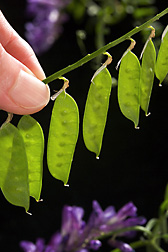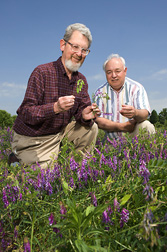New Vetch for Northern Climes—and Organic Growers
|
|
Hairy vetch (Vicia villosa) is a winter cover crop used to reduce weed competition and herbicide applications, improve soil quality and tilth, and provide symbiotically fixed nitrogen to nourish crops that follow it.
Vetch is especially valuable in organic production systems, but conventional farmers are also interested because hairy vetch mulch can lower their nitrogen fertilizer expenses by a third to a half and reduce pesticide loss in runoff.
Tom Devine, a geneticist and breeder with the Agricultural Research Service’s Sustainable Agricultural Systems Laboratory in Beltsville, Maryland, has released a new variety of hairy vetch named “Purple Bounty” that should expand use of vetch throughout the Northeast. He released Purple Bounty with the Rodale Institute near Kutztown, Pennsylvania; the Cornell University Agricultural Experiment Station at Ithaca, New York; and the Pennsylvania Agricultural Experiment Station at University Park.
|
|
Spring Sun and Fixing Nitrogen
Hairy vetch is planted in the fall and starts growth before becoming dormant in winter. In spring, with the long days that power photosynthesis, the plants make abundant growth and fix large quantities of nitrogen in symbiosis with soil bacteria. In late spring, the vetch plants can be tilled into the soil or rolled down and killed, leaving a 3/4-inch-thick thatch mat of dead stems that serves as weed-smothering mulch. This mat also keeps moisture in the soil, slows down rain runoff, and protects soil from eroding. But hairy vetch’s main contribution to soil is nitrogen, which can then be used by the main crop, such as corn, tomatoes, or pumpkins. The main crop is planted through the thatch into the soil.
Use of vetch has been restricted by the late-flowering characteristic of available varieties. If the vetch is rolled down before the plants have flowered, it will regrow and compete with the main crop. Purple Bounty was bred to flower 2 weeks earlier than a commonly used variety. This allows farmers to plant their main crop earlier in spring and use cultivars of corn and tomatoes that require a longer growing season.
Winter Kill and Flowering Nature
Until now, hairy vetch has had limited use north of Maryland because it copes poorly with northern winters. But Purple Bounty has survived winters as far north as upstate New York.
Devine has been working on breeding this new variety for 9 years. Using traditional breeding methods so that varieties he develops will be acceptable to organic farmers, he started with several hairy vetch types from the U.S. National Plant Germplasm System, then maintained in Georgia. There he found early-flowering types of hairy vetch, but they were not winter-hardy enough to survive northern winters.
Devine began a program with this germplasm to select for improved winterhardiness while maintaining early flowering. He harvested seed from plants that survived winters at Beltsville and at the University of Maryland farm at Keedysville, in the northern Maryland foothills region. After nine cycles of selection, Purple Bounty emerged with the right blend of winterhardiness and early flowering.
Seed increase of Purple Bounty is being made in the 2007-2008 season. Limited quantities of seed should be available for planting in 2008 with commercial quantities available in 2009.—By Don Comis, Agricultural Research Service Information Staff.
This research is part of Integrated Agricultural Systems (#207), an ARS national program described on the World Wide Web at www.nps.ars.usda.gov.
Thomas E. Devine is with the USDA-ARS Sustainable Agricultural Systems Laboratory, 10300 Baltimore Ave., Bldg. 001, BARC-West, Beltsville, MD 20705; phone (301) 504-7199, fax (301) 504-6491.
"New Vetch for Northern Climes—and Organic Growers" was published in the April 2008 issue of Agricultural Research magazine.








